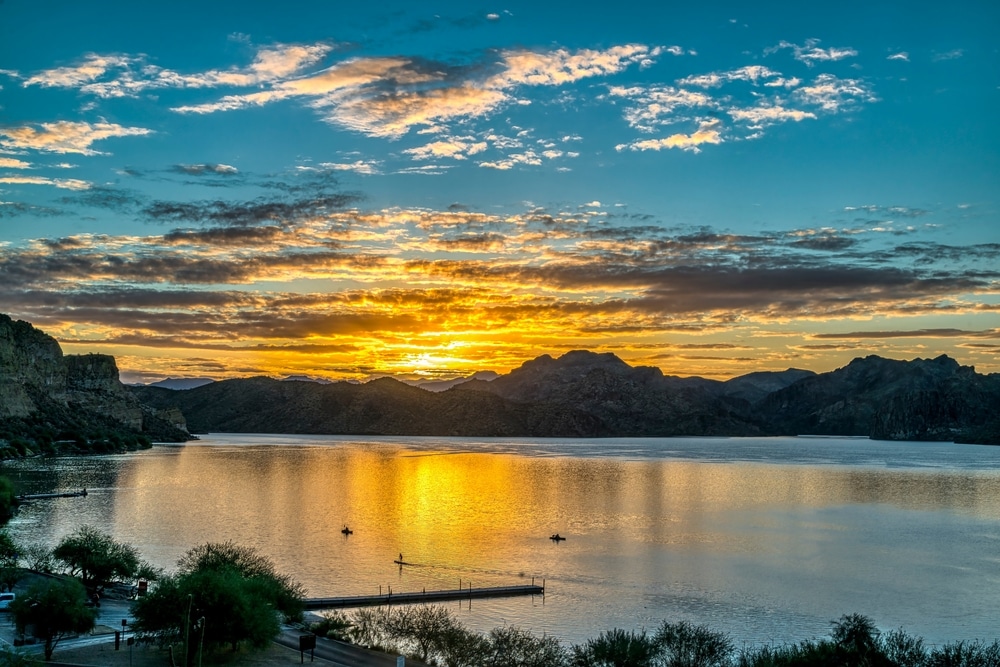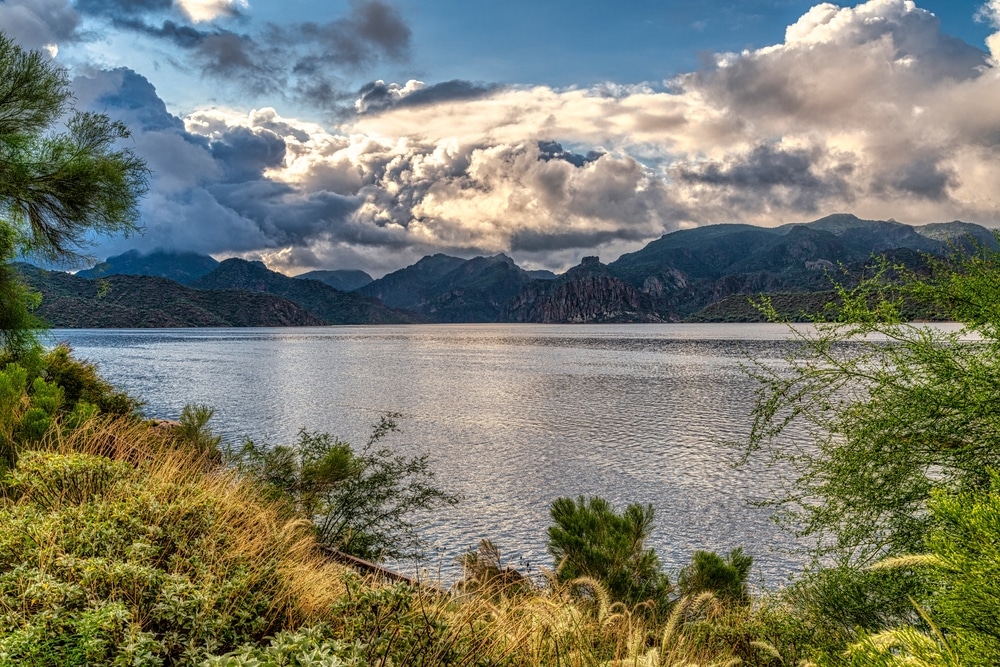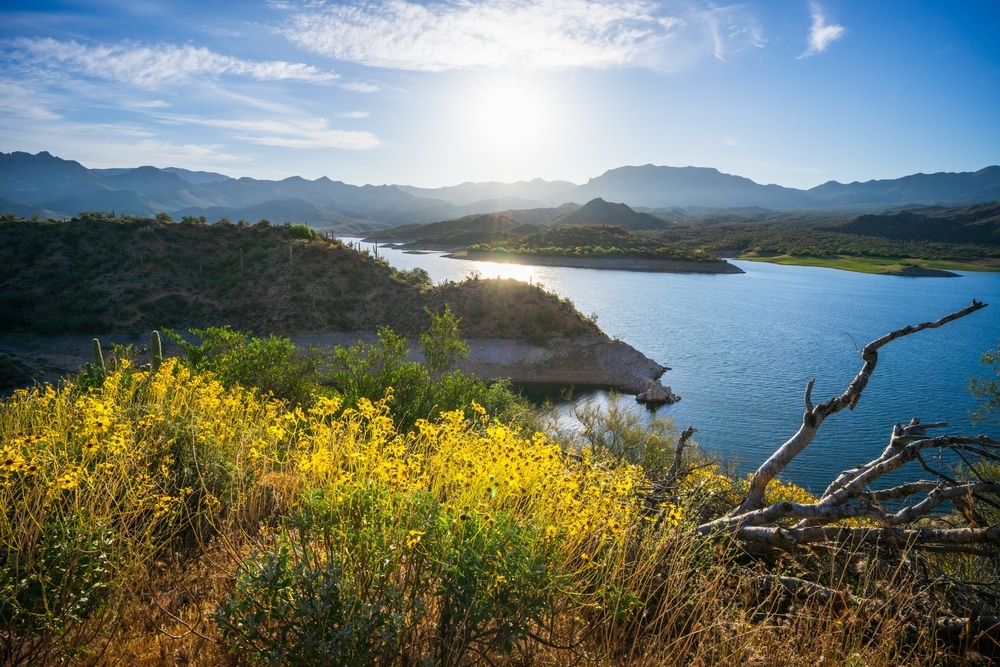- Privacy
- Terms
- Stay Connected
Nestled amid the rugged beauty of the Sonoran Desert, Saguaro Lake emerges as a shimmering oasis of blue against a backdrop of dramatic canyon walls and iconic saguaro cacti. This desert jewel, located just 41 miles northeast of Phoenix (coordinates: 33°33′56″N 111°32′10″W), offers a perfect escape from the urban hustle while remaining easily accessible via State Route 87 (Beeline Highway) or Bush Highway. Visitors from Phoenix, Scottsdale, Mesa, and Fountain Hills can reach this natural wonder in under an hour, making it a beloved recreational destination for both locals and tourists alike.
Created by the damming of the Salt River, Saguaro Lake stands as a testament to human ingenuity and Arizona’s commitment to water management. This man-made reservoir was formed when the Stewart Mountain Dam was completed in 1930, serving as the fourth and final reservoir on the Salt River as part of the Salt River Project (SRP). Named for the majestic saguaro cactus that dots its shoreline, the lake plays a crucial role in Arizona’s water system by providing storage capacity, flood control, and hydroelectric power while simultaneously offering a recreational paradise.

Despite its artificial origins, Saguaro Lake has seamlessly integrated into the natural landscape, becoming an essential ecosystem for numerous plant and animal species while offering visitors a genuine desert lake experience. Whether you come for the excellent fishing, water sports, wildlife viewing, or simply to absorb the breathtaking desert scenery, Saguaro Lake promises an unforgettable Arizona adventure.


The Desert Belle is a double-decker tour boat that has been operating on Saguaro Lake since 1964. The 90-minute narrated cruises provide fascinating information about the lake’s history, wildlife, and geology while passengers enjoy the spectacular scenery from comfortable seating. Special sunset cruises and music cruises are available seasonally, offering unique perspectives of the desert landscape.

Butcher Jones Beach offers the lake’s primary designated swimming area with amenities including picnic tables, restrooms, and a sandy beach. This developed recreation site provides ideal conditions for families, with gradual-entry shorelines and protected swimming areas. During summer months, the warm water temperatures make swimming particularly enjoyable, offering refreshing relief from the desert heat.

The sheltered coves and dramatic canyon walls make Saguaro Lake ideal for paddle sports. Kayakers and paddleboarders can explore hidden alcoves inaccessible to larger boats and enjoy close encounters with desert wildlife. The morning hours typically offer calmer water conditions with less boat traffic. Equipment rentals are available at the marina, and guided paddling tours can be arranged through local outfitters.

Saguaro Lake is stocked with various fish species, making it a popular fishing destination. Anglers can target largemouth bass, smallmouth bass, yellow bass, rainbow trout, bluegill, and catfish. The numerous coves and submerged structures create productive fishing spots, with the area near the dam and the Salt River inlet being particularly rewarding. Fishing is accessible from both boat and shore, with best results typically occurring at dawn and dusk.

The Butcher Jones Trail extends 5 miles along the lakeshore, offering spectacular views and access to secluded coves. This moderate hiking path showcases native desert vegetation and provides numerous vantage points for photography. The nearby Water Users Recreation Area offers additional hiking opportunities along the Lower Salt River, with trails connecting to the extensive Tonto National Forest network.

Saguaro Lake and the surrounding desert provide habitat for diverse wildlife, including desert bighorn sheep, bald eagles, great blue herons, and wild horses. The narrow Salt River inlet is particularly known for wildlife sightings, as animals come to the water’s edge to drink. Early morning and late afternoon offer the best viewing opportunities, with patient observers often rewarded with remarkable encounters.

While overnight camping is not permitted at Saguaro Lake itself, the adjacent Tonto National Forest offers numerous developed and primitive camping options within a short drive. For day visitors, multiple picnic areas with tables, grills, and shade ramadas are available at Butcher Jones Beach and the Saguaro Lake Marina. These facilities provide comfortable spaces to enjoy meals with spectacular lake views.

The striking contrast between blue waters, red canyon walls, and green saguaro cacti creates exceptional photography opportunities. Sunset and sunrise are particularly magical as the changing light brings the desert landscape to life with vibrant colors. The view from the Saguaro Lake Vista point offers panoramic photo possibilities, while boat access allows photographers to capture unique perspectives from the water.
Saguaro Lake offers some of the finest sport fishing in central Arizona, with a diverse population of game fish that attracts anglers year-round. The lake hosts an impressive variety of fish species, including largemouth bass, smallmouth bass, yellow bass, crappie, sunfish, bluegill, rainbow trout, walleye, channel catfish, and carp. Largemouth bass fishing is particularly renowned, with the lake producing trophy-sized specimens that regularly exceed 5 pounds, and record catches in the 12+ pound range have been documented.
The lake’s standing as a premier bass fishing destination is supported by extensive habitat improvement efforts. The Arizona Game and Fish Department has installed over 2,200 fish-habitat structures throughout the lake, creating ideal conditions for fish to thrive. Anglers targeting trophy bass find the best success during two prime seasons: October through December and February through mid-April, as noted by Bass Master Magazine.
For those seeking productive fishing spots, several areas stand out. The narrow canyon section provides excellent structure for bass and crappie, while the shallow coves near Butcher Jones Beach can be productive for multiple species. The eastern end of the lake, particularly Burro Cove at the terminus of the Butcher Jones Trail, offers quality fishing with less boat traffic. Shore fishing is available at several locations, including the Peregrine Point Fishing Dock near Butcher Jones Recreation Area, though serious anglers generally prefer fishing from boats to access the lake’s deeper sections and hidden coves.
Fishing techniques vary by season and target species. During warmer months, early morning and late evening fishing with topwater lures works well for bass, while drop-shotting plastic worms in deeper water proves effective during midday heat. Winter months see trout stocking by the Arizona Game and Fish Department, with bait fishing using PowerBait or small spinners producing results. Arizona fishing regulations apply at Saguaro Lake, with all anglers 10 years and older required to possess a valid Arizona fishing license. Special bag limits and length restrictions may apply to certain species, so checking current regulations before your trip is advisable. Local fishing guides and occasional tournaments provide opportunities for newcomers to learn from experienced anglers.
Boating stands as one of Saguaro Lake’s premier attractions, with the lake’s 22 miles of shoreline and varied terrain creating an ideal environment for watercraft of all types. Motorized boats, including powerboats, pontoons, jet skis, and fishing vessels, are permitted on the lake with no horsepower restrictions, though noise limits are enforced (boats must not exceed 82 decibels). Non-motorized options such as kayaks, canoes, paddleboards, and sailboats are also welcome, with the lake’s protected coves providing perfect conditions for these quieter craft.
The Saguaro Lake Marina at the Saguaro del Norte Recreation Site serves as the primary access point for boaters, featuring two well-maintained paved launch ramps with ample preparation areas. The main marina lot offers parking for vehicles and trailers, though spaces fill quickly on summer weekends and holidays—arriving by 8 AM is recommended during peak times. A secondary parking area becomes available when the main lot reaches capacity, but this often means waiting for spaces to open.
Navigation on Saguaro Lake requires attention to several designated zones and natural hazards. The area directly in front of the Saguaro del Norte Recreation Site and Butcher Jones Beach is designated as a no-wake zone for motorized craft. Similarly, the narrow canyon passage and the eastern end of the lake are no-wake areas to preserve the tranquil environment and protect shorelines. The lake follows a counterclockwise traffic pattern for motorized vessels during busy periods. Boaters should watch for submerged rocks, particularly in areas with steep shorelines and during periods of lower water levels. Channel markers help guide safe passage through narrower sections.
Boat rentals are readily available at the Saguaro Lake Marina through Precision Marine, offering pontoon boats, fishing boats, and personal watercraft. Half-day and full-day rental options accommodate various schedules and budgets. The marina also provides essential services including fuel sales, boat slips for temporary mooring, longer-term boat storage options, and a small store with boating supplies. For those seeking a more structured experience, the Desert Belle cruise boat offers 90-minute narrated tours of the lake aboard a double-decker paddleboat, complete with air conditioning, snacks, and beverage service.
Saguaro Lake provides exceptional opportunities for swimming and water sports against the dramatic backdrop of desert cliffs and saguaro-studded hills. Butcher Jones Beach, located on the northeastern shore of the lake, serves as the primary designated swimming area. This sandy beach area features 32 picnic sites with tables and grills, restroom facilities, and gradual entry into the water, making it ideal for families with children. The beach is set in a no-wake zone, ensuring a safe environment free from boat traffic. The water quality at Saguaro Lake is regularly tested and generally remains excellent for swimming, though occasional algae blooms may occur during hot summer months.
Beyond swimming, Saguaro Lake is a paradise for water sports enthusiasts. Water skiing and wakeboarding are popular activities in the main basin area where there’s ample room for boats to maneuver. The water skiing season typically runs from April through October, though dedicated enthusiasts with wetsuits extend their season year-round. Jet skiing is permitted throughout most of the lake except in designated no-wake zones, with the open areas of the main basin providing perfect conditions for high-speed fun.
For those preferring a more relaxed pace, paddleboarding and kayaking offer excellent ways to explore the lake’s quieter coves and shorelines. The eastern narrow section of the lake, with its protected waters and stunning canyon scenery, provides an ideal setting for these activities. Paddleboard and kayak rentals are available from various outfitters in the Mesa area, with some offering delivery to the lake for convenience. Many feature inflatable models that simplify transportation.
Captain’s Cove, located a short distance from the marina, has become a favorite gathering spot for families engaging in water play, with its protected position and slightly warmer waters. The area beyond the main basin, entering the canyon section, offers several small beaches accessible only by boat, providing more secluded swimming opportunities. All water activities should be approached with appropriate safety measures—life jackets are required for children 11 and under while on the water, and orange warning flags must be displayed when swimmers are in the water near boats.

| Category | Details |
|---|---|
| Location | Maricopa County, Arizona, USA (about 40 miles northeast of Phoenix) |
| Formation | Created by Stewart Mountain Dam, completed in 1930 |
| Surface Area | Approximately 1,264 acres (5.1 km²) |
| Length | About 10 miles (16 km) |
| Maximum Depth | Around 118 feet (36 m) |
| Storage Capacity | 69,765 acre-feet (86 million m³) |
| Dam Type | Concrete arch |
| Dam Height | 207 feet (63 m) |
| Dam Length | 517 feet (158 m) |
| Water Source | Salt River |
| Purpose | Water storage, hydroelectric power, recreation |
| Hydroelectric Capacity | 13 megawatts |
| Named After | Saguaro cactus prominent in the surrounding landscape |
| Management | Tonto National Forest (U.S. Forest Service) |
| Recreation | Boating, fishing, kayaking, paddleboarding, hiking |
| Notable Fish Species | Largemouth bass, yellow bass, bluegill, crappie, catfish |
| Facilities | Marina, restaurant, boat rentals, picnic areas, camping nearby |
| Part Of | Salt River Project (SRP) chain of lakes |
| Position in Chain | Fourth and last reservoir in the Salt River chain |
| Nearby Attractions | Butcher Jones Recreation Area, Desert Belle Cruise boat tours |
| Wildlife | Bald eagles, great blue herons, desert bighorn sheep |
| Notable Feature | Surrounded by dramatic desert landscape with steep canyon walls |
Saguaro Lake spans approximately 1,200 acres, creating a substantial body of water within the arid Sonoran Desert landscape. The lake extends about 10 miles in length and features more than 22 miles of scenic shoreline, providing ample space for various recreational activities. At its deepest point, the lake plunges to approximately 110 feet, while maintaining an average depth of around 90 feet, making it suitable for diverse aquatic life and water-based activities.
The lake’s surface sits at an elevation of 1,506 feet (459 meters) above sea level. Its distinctive shape is defined by the natural topography of the Salt River valley, creating a narrow, winding body of water that mimics the original river’s course. Saguaro Lake is divided into two main sections connected by a narrow channel bordered by impressive canyon walls. The lower main portion offers a wider water surface, while the narrower eastern end provides access to camping areas and more secluded spots.
As a reservoir on the Salt River, Saguaro Lake receives its primary water source from upstream flows regulated by the other Salt River dams—Roosevelt, Horse Mesa, and Mormon Flat. The lake’s water quality typically remains good throughout the year, though clarity can vary seasonally with rainfall patterns and algae levels. Water temperatures range from around 55°F in winter months to over 80°F during the height of summer, creating comfortable swimming conditions from late spring through early fall.
The surrounding landscape is characterized by steep, rugged terrain typical of the Tonto National Forest. The shoreline features dramatic canyon walls, rocky cliffs, and pockets of sandy beaches. The desert ecosystem is dominated by saguaro cacti, palo verde trees, mesquite, creosote bush, and ocotillo, creating a quintessential Sonoran Desert environment. The lake occupies a portion of the Salt River watershed, which ultimately feeds into the Gila River system. Geologically, the area showcases layers of ancient sedimentary and volcanic rock, with the iconic saguaro cacti standing sentinel over this desert waterway.
The Stewart Mountain Dam, the architectural triumph that created Saguaro Lake, stands as a monument to early 20th-century engineering ingenuity. Constructed between 1928 and 1930 by the Salt River Valley Water Users’ Association (now known as the Salt River Project or SRP), the dam was built to complete the comprehensive water management system along the Salt River. Named after the Old Stewart Ranch that once occupied nearby land, the dam represents the final piece in a series of water control projects that transformed Arizona’s agricultural potential.
Stewart Mountain Dam is classified as a concrete thin-arch dam, a design chosen for its strength and efficiency in the narrow canyon setting. Rising 212 feet (65 meters) from its foundation and spanning 583 feet (178 meters) in length, the dam curves elegantly across the Salt River gorge. The structure features gravity abutments on either side to anchor the arch securely to the canyon walls. This architectural design allows the dam to transfer the water pressure into the surrounding rock formations.
The Salt River Project (SRP) manages the dam as part of its comprehensive water and power system. One of the dam’s most significant features is its 13,000-kilowatt hydroelectric generating unit, which helps supply clean energy to the greater Phoenix metropolitan area. This generating capacity is particularly valuable during peak summer months when electricity demand in Phoenix reaches its highest levels.
Construction of Stewart Mountain Dam marked the completion of an ambitious infrastructure project that began with Roosevelt Dam in 1911. Stewart Mountain, along with Horse Mesa and Mormon Flat dams (completed between 1923 and 1930), more than doubled SRP’s hydropower generating capacity. The revenue generated from these power facilities helped repay the federal government for the construction of Roosevelt Dam and financed the bonds used for the subsequent lower Salt River dams.
The dam underwent significant modifications by the Bureau of Reclamation in 1936, including the addition of a concrete-lined spillway discharge channel and upgraded gate operating mechanisms. More extensive renovations occurred between 1988 and 1992 to address safety concerns related to potential maximum floods and earthquake resistance. These improvements included constructing a new spillway, reinforcing the abutments with concrete overlays, replacing the penstock and outlet works, raising the road on top of the dam, drilling drainage holes to relieve hydraulic pressure, and installing 84 steel cables through the dam and into its foundation for additional strength.
Public access to the dam itself is limited for security and safety reasons, though the impressive structure can be viewed from certain vantage points around the lake. The dam’s completion not only created a valuable water storage facility but also formed what would become one of Arizona’s most beloved recreational destinations, blending utility with natural beauty in the Sonoran Desert.
Camping options at Saguaro Lake are limited but distinctive, offering a unique outdoor experience for those willing to access sites by boat. Bagley Flat Campground, located approximately 4 miles from the dam on the eastern end of the lake, provides the only designated camping area directly on Saguaro Lake. This boat-access-only campground features 10 designated primitive sites equipped with picnic tables and grills. A vault toilet facility serves the campground, but no drinking water or trash service is available—campers must pack out all waste. The campground operates on a first-come, first-served basis with no reservations accepted, making early arrival essential during peak seasons.
For those seeking a more accessible camping experience, alternatives can be found in the surrounding Tonto National Forest. While not directly on Saguaro Lake, these nearby campgrounds offer a similar desert environment with easier vehicle access. Campers should note that the Butcher Jones Recreation Area, despite its popularity for day use, does not permit overnight camping.
Visitors preferring more comfortable accommodations will find the Saguaro Lake Guest Ranch to be a perfect compromise between wilderness and comfort. Located approximately 5 miles south of the lake on the Bush Highway, this historic ranch was originally built in the 1930s to house workers constructing Stewart Mountain Dam. Today, it offers charming cabin accommodations in a scenic setting along the Salt River. The ranch provides various amenities including a swimming pool, horseback riding during fall, winter, and spring, and river recreation activities like kayaking and tubing during summer months. Rates typically range from $140-$220 per night depending on cabin size and season.
For those preferring standard hotel accommodations, the nearest options are located in Fountain Hills (approximately 25 minutes away) and Mesa (about 30 minutes away). Fountain Hills offers several mid-range hotels with rates ranging from $100-$200 per night, while Mesa provides a wider range of accommodations from budget motels ($60-$90) to upscale resorts ($200-$350).
Vacation rentals present another popular option in the area, with numerous properties available through online platforms. These range from modest desert homes to luxury properties with pools, typically priced between $150-$400 per night depending on size, amenities, and proximity to the lake. Most vacation rentals require a minimum two-night stay, with some owners offering discounts for longer bookings.
All accommodation options near Saguaro Lake tend to book quickly during peak seasons (spring and fall) and holiday weekends. Advance reservations of 3-6 months are recommended for the Saguaro Lake Guest Ranch and popular vacation rentals, particularly for visits during the ideal weather months of March through May and October through November.
The ecosystem surrounding Saguaro Lake represents a rich blend of Sonoran Desert and riparian habitats, creating an environment where diverse species thrive in close proximity to water—a precious resource in this arid landscape. The vegetative community is dominated by the iconic saguaro cactus (Carnegiea gigantea), which stands as the namesake and symbolic guardian of the lake. These majestic plants, which can live for over 150 years and grow up to 60 feet tall, create the distinctive silhouette associated with Arizona’s deserts. Alongside them, other cacti species including prickly pear, cholla, and barrel cactus add to the textural diversity of the landscape.
The transition zones between desert and water support crucial plant species including mesquite trees (Prosopis spp.), palo verde trees (Parkinsonia spp.), and creosote bush (Larrea tridentata). In moister areas, especially near inlets and sheltered coves, cattails and other riparian vegetation create small wetland microclimates. Seasonal wildflowers transform the landscape after winter rains, with Mexican gold poppies, lupines, and brittlebush creating brilliant displays typically peaking in March and April.
The avian population around Saguaro Lake is particularly diverse and offers excellent bird-watching opportunities year-round. Bald eagles, ospreys, and peregrine falcons patrol the skies, while great blue herons and various waterfowl species frequent the shorelines. The desert uplands host cactus wrens, Gila woodpeckers, curve-billed thrashers, and various hummingbird species. Many migratory birds use the lake as a vital stopover during spring and fall migrations, temporarily swelling the bird diversity.
Mammals found in the Saguaro Lake environment range from small desert specialists to larger species drawn to the water source. Desert cottontails, jackrabbits, ground squirrels, and various species of mice and rats form the foundation of the food chain. Larger mammals include coyotes, gray foxes, ringtails, javelinas, and bobcats. Perhaps most impressively, desert bighorn sheep can occasionally be spotted on the steep canyon walls surrounding the lake, particularly during early morning or late afternoon hours. Lucky visitors might glimpse mule deer coming to drink at dawn or dusk.
The reptile community includes numerous lizard species such as the greater earless lizard, desert spiny lizard, and the colorful collared lizard. Several snake species inhabit the area, including non-venomous gophersnakes and kingsnakes, along with venomous western diamondback rattlesnakes and Mojave rattlesnakes. Various amphibians, particularly toads like the Sonoran Desert toad, become active during summer monsoon season.
Conservation efforts in the Saguaro Lake ecosystem focus on several key challenges. The Arizona Game and Fish Department conducts regular water quality monitoring, crucial for maintaining both recreational safety and wildlife habitat quality. Invasive species management targets both aquatic threats like quagga mussels and terrestrial problems like buffelgrass, which increases fire risk in an ecosystem not adapted to frequent burning. Recent fish kills attributed to golden algae outbreaks (documented in 2017-2019 and 2022) have prompted increased monitoring and research into prevention strategies.
The best wildlife viewing locations include the Butcher Jones Trail, which traverses diverse habitat types along the lake’s northeastern shore, and the water’s edge at dawn and dusk when animals are most active. The Desert Belle cruise offers a unique perspective for viewing wildlife along the shorelines and canyon walls without disturbing natural behaviors. Interpretive programs led by Tonto National Forest rangers during peak seasons provide insights into the ecosystem’s complexity and conservation challenges.
Saguaro Lake offers year-round recreational opportunities, though each season presents distinctive characteristics, advantages, and challenges for visitors. Understanding these seasonal patterns helps in planning the optimal visit based on preferred activities and comfort preferences.
Spring (March-May) stands as perhaps the most idyllic time to visit Saguaro Lake. Daytime temperatures typically range from 70-90°F (21-32°C), creating comfortable conditions for all outdoor activities. The desert landscape often explodes with wildflowers following winter rains, adding splashes of color to the surrounding hills. Water temperatures gradually warm to the mid-60s°F by late April, making swimming increasingly pleasant later in the season. Fishing peaks during this period, particularly for bass as they move into shallower waters for spawning. Weekends can become quite busy during spring, especially in April, as visitors from Phoenix seek respite before summer heat settles in.
Summer (June-September) brings intense heat to the Sonoran Desert, with daytime temperatures consistently exceeding 100°F (38°C) and occasionally reaching 110°F (43°C) or higher. The lake becomes a critical cooling resource for residents of the Phoenix metropolitan area, resulting in significant crowds, particularly on weekends and holidays. Early morning starts (before 8 AM) are strongly recommended to secure parking and boat launch access during this season. Water temperatures reach their peak of 80-85°F (27-29°C), providing refreshing relief from the heat. The monsoon season typically begins in early July, bringing spectacular afternoon thunderstorms but also creating potential hazards on the water. Lightning, sudden wind shifts, and flash flooding in side canyons require vigilance and weather monitoring.
Fall (October-November) rivals spring as the optimal time to visit. Temperatures moderate to 65-85°F (18-29°C), providing excellent conditions for hiking, boating, and shoreline activities. Water temperatures gradually cool but remain comfortable for swimming well into October. The lake typically experiences lower visitation during fall weekdays, offering a more peaceful experience. Fall brings the second peak for bass fishing as cooler water temperatures drive fish into more active feeding patterns. October often features special events including fishing tournaments and harvest-themed Desert Belle cruises.
Winter (December-February) transforms Saguaro Lake into a tranquil retreat with significantly fewer visitors. Daytime temperatures average 60-70°F (15-21°C)—mild compared to much of the country but generally too cool for water activities without wetsuits. Occasional cold fronts can drop temperatures into the 40s°F (4-9°C), especially in January. Water clarity often reaches its peak during winter months due to reduced algae growth and less recreational disturbance. Fishing remains productive, with rainbow trout stocking typically occurring in winter months. The surrounding landscape adopts more subtle tones, and wildlife viewing opportunities improve as animals become more active during daylight hours in the cooler temperatures.
Water levels in Saguaro Lake tend to remain relatively stable throughout the year compared to other Arizona reservoirs, as Stewart Mountain Dam primarily serves for hydroelectric generation rather than large-scale irrigation storage. However, extended drought periods can lead to lower water levels, particularly evident in exposed shorelines and emerging navigation hazards. Current water level information can be obtained from the Salt River Project at 602-236-5929 before planning water activities.
Saguaro Lake is located within the Tonto National Forest and requires a Tonto Daily Pass for entry, which costs $8 per vehicle per day. These passes can be purchased at the ranger station near the entrance or at self-service machines in the parking areas. An additional Watercraft Use Fee of $4 per boat is required for those launching watercraft. For frequent visitors, the Tonto National Forest Annual Pass ($80) provides better value. America the Beautiful Federal Recreation Passes (Annual, Senior, Military, and Access) are also honored for entry, though the watercraft fee may still apply. Fishing requires a valid Arizona fishing license, available online through the Arizona Game and Fish Department or at local sporting goods stores.
The Saguaro Lake recreation areas (Saguaro del Norte and Butcher Jones) are open year-round, with gates opening at 6:00 AM daily. Closing hours vary seasonally: 8:00 PM during summer months (April through September) and earlier during winter months. The lake itself never closes for those already on the water or accessing it from private property, though night navigation requires proper lighting.
The Mesa Ranger District of the Tonto National Forest oversees Saguaro Lake. A ranger station is located at the entrance to Saguaro del Norte Recreation Site, staffed during daylight hours most days. Rangers provide information, enforce regulations, and can assist with emergencies. The ranger station phone number is (480) 610-3300 for non-emergency inquiries.
The Maricopa County Sheriff’s Office maintains a patrol boat on Saguaro Lake during busy periods, with a sheriff’s aid station located at the Saguaro del Norte Recreation Site. For emergencies, call 911—the dispatchers will coordinate appropriate response from sheriff’s deputies, forest rangers, or medical services. The closest hospital facilities are in Fountain Hills and Mesa, both approximately 25-30 minutes from the lake.
Cell phone coverage at Saguaro Lake varies by carrier and location. The main recreation areas (Saguaro del Norte and Butcher Jones) generally have reliable service for major carriers. Coverage becomes spotty in the canyon sections and eastern portions of the lake, with some areas having no service at all. Downloading maps and essential information before arrival is recommended.
Saguaro Lake offers several accessibility accommodations for visitors with disabilities. The Saguaro del Norte Recreation Site features ADA-compliant restrooms, paved paths to picnic areas, and a wheelchair-accessible fishing dock. The Desert Belle cruise boat is equipped with wheelchair access to the main deck. Butcher Jones Recreation Area has limited accessibility with some paved pathways but more challenging terrain.
Potable drinking water is available at the Saguaro del Norte Recreation Site near the marina and at the Butcher Jones Recreation Area. However, no drinking water is available at Bagley Flat Campground or in more remote areas of the lake. Visitors should bring ample water supplies, particularly during hot months.
Trash receptacles are provided at developed recreation sites including Saguaro del Norte and Butcher Jones. No trash service exists at Bagley Flat Campground or remote shoreline areas—visitors must pack out all waste from these locations. The marina provides facilities for proper disposal of fishing line and hooks to protect wildlife.
Fire restrictions vary seasonally based on conditions. During high fire danger periods (typically May through July), open fires may be completely prohibited. When allowed, fires must be contained within designated fire rings or grills at developed sites. Current fire restriction information can be obtained from the Tonto National Forest website or by calling the ranger station before your visit.
Dogs are permitted in developed recreation areas and on boats but must be kept on leashes no longer than six feet at all times. Pet waste must be collected and properly disposed of. Dogs are not allowed in designated swimming areas for health and safety reasons. Bringing pets to the lake during extremely hot days is discouraged due to heat risks and hot surfaces that can burn paws.
The areas surrounding Saguaro Lake offer numerous opportunities to extend your desert adventure beyond the water. The nearest substantial communities are Fountain Hills (14 miles west), Mesa (20 miles southwest), and Scottsdale (25 miles west), each providing various amenities and attractions worth exploring.
The charming town of Fountain Hills, named for its spectacular fountain that sends water soaring 560 feet into the air, serves as an excellent basecamp for lake visitors. The town center features several quality restaurants including Phil’s Filling Station (American cuisine with a 1950s gas station theme), Sofrita (Caribbean/Latin fusion), and All American Sports Grill (casual dining with multiple TVs for sports viewing). For grocery needs, the Safeway and Bashas’ supermarkets in Fountain Hills stock everything needed for lakeside picnics and camping supplies.
Along the Bush Highway connecting Mesa to Saguaro Lake, several attractions merit consideration. The Saguaro Lake Ranch, beyond its accommodation options, offers guided horseback rides through desert terrain with spectacular views. These 1-2 hour rides require no previous riding experience and provide a traditional way to experience the Sonoran landscape. During summer months, Salt River Tubing operates just south of the lake, offering refreshing float trips down the regulated river flow below Stewart Mountain Dam—a popular activity during hot months.
Within a one-hour drive, several significant attractions stand out. Lost Dutchman State Park (25 minutes south) provides excellent hiking opportunities in the legendary Superstition Mountains, with trails ranging from easy nature walks to challenging summit climbs. The park’s visitor center offers fascinating exhibits on the area’s mining history and the famous “Lost Dutchman’s Gold Mine” legend. Adjacent to the park, the Superstition Mountain Museum displays mining equipment, historical buildings, and artifacts from the area’s colorful past.
For those interested in Native American history, the ancient Hohokam ruins at Mesa Grande Cultural Park (35 minutes from the lake) showcase remains of platform mounds and irrigation systems created by the region’s earliest agricultural inhabitants. Further afield, the internationally renowned Musical Instrument Museum in north Phoenix (45 minutes from the lake) houses an astounding collection of over 8,000 instruments from around the world, with audio and video displays bringing the sounds to life.
The area’s indigenous history remains evident through rock art sites near the lake. The Stewart Mountain Dam Petroglyphs Trail, accessible from the Saguaro Lake Marina area, features ancient Hohokam petroglyphs alongside views of the modern dam structure—a striking juxtaposition of ancient and contemporary engineering. These petroglyphs, believed to be 500-1,000 years old, provide a glimpse into the area’s original inhabitants who recognized the importance of the Salt River long before modern water management systems were conceived.
For those interested in wildlife viewing beyond the immediate lake environment, the Southwest Wildlife Conservation Center in Scottsdale (40 minutes from the lake) provides sanctuary for injured and rescued desert wildlife including mountain lions, bears, and Mexican gray wolves, with educational tours available by reservation.
Beyond standard outdoor gear, several items prove particularly valuable at Saguaro Lake. A wide-brimmed hat provides better sun protection than caps alone in this reflective environment. Polarized sunglasses reduce glare off the water, improving both comfort and the ability to spot underwater features. A minimum SPF 30 sunscreen is necessary, with reapplication every two hours due to water and sweat. Quick-dry clothing with UPF protection helps manage the heat while preventing sunburn. For footwear, water shoes with sturdy soles protect against hot surfaces and rocky shorelines. Insulated water containers keep drinks cold in extreme heat—plan for at least one gallon per person per day during summer.
The Arizona sun demands serious respect, particularly at Saguaro Lake where water reflection intensifies UV exposure. Beyond sunscreen, consider timing activities to avoid the harshest midday rays (10 AM-4 PM). Portable shade structures or umbrellas prove invaluable for shoreline activities, particularly at Butcher Jones Beach where natural shade is limited. Remember that UV penetrates cloud cover, necessitating sun protection even on overcast days. Regular hydration supports your body’s natural cooling mechanisms—drinking before feeling thirsty prevents dehydration.
Heat exhaustion and heat stroke pose real risks, particularly during summer months. Learn to recognize early warning signs including headache, dizziness, excessive sweating followed by cool, clammy skin, muscle cramps, and nausea. Immediate treatment involves moving to shade, cooling with water, and hydration with electrolyte-containing beverages. Children and older adults face higher risk and require closer monitoring. Pre-cooling before outdoor activity by starting well-hydrated and wearing dampened neck cloths can delay heat buildup.
Sunrise at Butcher Jones Beach offers spectacular light on the saguaro-studded hills with pink and gold reflections on calm morning water. For sunset photography, the vista point near the marina parking area provides panoramic views as the western light illuminates canyon walls with rich orange and red tones. Wildlife photography proves most productive during early morning hours when animals visit the water’s edge. The view from Pinter’s Point (accessible via moderate hiking on the Butcher Jones Trail) provides one of the most comprehensive lake panoramas.
Several less-frequented areas reward explorers willing to venture beyond the main recreation sites. Ship Rock, a distinctive formation visible from the main basin, creates a natural reference point and interesting compositional element for photographs. The narrow canyon section beyond the main basin offers intimate views of sheer cliffs and protected coves perfect for swimming away from crowds. Burro Cove, at the terminus of the Butcher Jones Trail, provides excellent shoreline fishing access with fewer visitors than main areas.
Saguaro Lake’s proximity to Phoenix creates significant visitation pressure, particularly on weekends. Weekday visits, especially Tuesday through Thursday, offer dramatically reduced crowds. During peak summer season, arriving before 8 AM virtually guarantees entry and parking availability. The winter months (December-February) see substantially fewer visitors overall. For those constrained to weekend visits, the eastern end of the lake accessed by boat typically remains less congested than the main basin and beach areas.
The desert ecosystem recovers slowly from human impacts, making responsible recreation crucial. Pack out all trash, including seemingly harmless items like fruit peels which require months to decompose in this environment. Avoid creating new trails or disturbing vegetation, as this contributes to erosion during monsoon rains. Keep motorized craft within designated areas to prevent shoreline erosion and habitat disruption. Proper disposal of fishing line prevents wildlife entanglement—specialized disposal containers are available at the marina.
Flash flooding presents a serious danger during monsoon season (July-September) when sudden storms can send walls of water through side canyons with little warning. During monsoon season, monitor weather conditions and have an evacuation plan. Rattlesnakes and scorpions are present in the desert landscape—inspect shoes and gear before use, stay on established paths, and maintain awareness, especially at night. Steep shorelines around the lake can present falling hazards; supervise children closely. During summer, surface temperatures on rocks and metal can exceed 150°F, causing severe burns with momentary contact—test surfaces before touching or allowing children or pets to walk on them.
Saguaro Lake stands as a testament to Arizona’s remarkable ability to blend natural beauty with human ingenuity. This desert oasis, cradled by rugged canyon walls and watched over by its namesake saguaro sentinels, offers a uniquely Arizonan experience where clear blue waters meet the iconic Sonoran Desert landscape. Whether you seek the thrill of water sports, the serenity of kayaking through narrow canyons, the excitement of landing a trophy bass, or simply the joy of a family picnic against a breathtaking backdrop, Saguaro Lake delivers experiences that remain etched in memory long after your visit.
As visitors to this special place, we each share responsibility for its preservation. The fragile desert ecosystem surrounding the lake, with its specialized plant and animal communities adapted to harsh conditions, requires our mindful stewardship. By observing regulations, practicing leave-no-trace principles, and treating the environment with respect, we help ensure that future generations will enjoy the same awe-inspiring experiences that we treasure today.
In a state defined by its dramatic landscapes and environmental contrasts, Saguaro Lake emerges as a place where these elements converge perfectly—where the harshness of the desert meets the life-giving properties of water, creating an environment that surprises and delights at every turn. Come discover why generations of Arizonans have called this lake one of the state’s most precious gems, and create your own story among the saguaros and sunlit waters of this desert paradise.